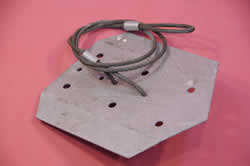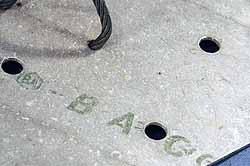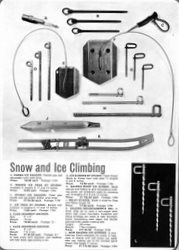
The Scottish Mountain Heritage Collection
Objects Database
'Dead man'
Accession Number
610.2008.1
Object Name
'Dead man'
Created
04/12/2008
Creator
Hermione Cooper
Accession Date
04/12/2008
Brief Description
A home made aluminium 'Dead man' Seven edges and nine holes in plate. Metal wire cable attached through two holes in centre.
Materials
aluminium
Dimensions
25(l) x 20.5 (w) cms
Number Of Objects
1
Inscription Description
On plate "BS 2L 73" and "L 13" and "B.A Co"
Colour
silver
Provenance
Dead Man anchors have been used for centuries to hold things in place, or for attaching some kind of pulley system to move things around. Although the name would seem to imply that some helpless corpse was used at some point in history, we haven't found any documentary evidence of that, the more likely system would be to bury logs or stones in soil, sand or snow with a rope or cable wrapped around it for attachment. It's thought that the first dead man anchors for mountaineering derived from dog sled drivers who used sheets of wood to anchor their dog teams in the snow. Scottish climber, John Cunningham worked for the British Antarctic Survey in the 1950's and we know that he experimented with metal and aluminium anchors in the Cairngorms on his return, though tradition has it that Denny Moorehouse of Clog Equipment was one of the first to produce a commercially available dead man back in the 1970's.
This is an excellent little timepiece being made by a member of Lochaber Mountain Rescue Team in the 1960's from materials 'borrowed' from the British Aluminium Company (hence the initials BA & Co) in Fort William. The maker has used a 'swage' to secure the ends. The swage is the little round aluminium bit which can be seen on the cable. When squeezed under heavy pressure it forms a very strong joint or weld.
We had an interesting note from Mountain Guide, Kathy Murphy:-
"On Gasherburn II in 1989 we made our own version out of the bottom of plastic barrels threaded with thin cord - they were somewhat rounder and larger than the deadman - understandably so - we called them deadwomen !!! ( they were also more difficult to place !)
Acquisition Date
04/12/2008
Condition Check Date
28/04/2009
Rules
Spectrum : UK Museum documentation standard, V.3.1 2007
Modified
28/04/2009



